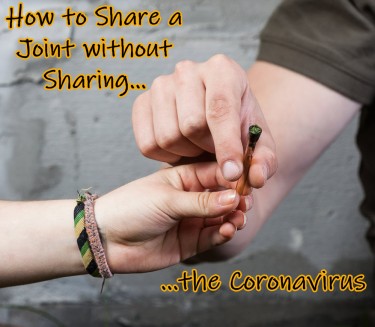
Can you share a joint without sharing germs, viruses, bacteria and cooties?
Many cannabis users are very familiar with the trend of sharing a joint. But is such a practice safe, or should it be avoided entirely? Are there valid reasons for concern or is there really no harm in sharing a joint? This article examines all of these questions and also suggests the safest ways to share weed with our friends.
Sharing together keeps friends together. One of the decent cultures among stoners is joint sharing. It has been a part of the culture for many years and the tradition will not end anytime soon. It is believed to be the best way to connect with old friends and connect with new ones. Puff, puff, pass is no coincidence in cannabis folklore.
On the other hand, there are concerns about hygiene, particularly among germaphobes, who find ingesting someone else’s oral fluid a disaster. And this attitude is perfectly understandable. Is this concern valid? Is it paranoia? If not, then what’s going on? To answer these questions, we must first study how germs spread. And while we may have a general idea of what germs are, we need to get more scientific here.
dr Speaking at the Cleveland Clinic, Michael Benniger, an otolaryngologist, claimed that human saliva is made up of enzymes and antibodies that help reduce contagious risks. However, he notes that activities involving the exchange of spit pose a fairly high risk. This implies that the spread of germs, as well as those that transmit serious infections, is easier to manage with a “wet” jiont.
It is also important to point out that different types of bacteria live and inhabit our environment. according to dr Christine Zurawski Bacteria and viruses are part of our everyday life. It’s just a matter of distinguishing the good from the bad. dr Zurawski found that bacteria present on personal items like our clothes and phones do no harm and are not a cause for concern. However, pathogens outside of our homes are the main cause for concern.
Can Sharing a Joint Make You Sick?
Philip Tierno, an NYU clinical professor in the Department of Microbiology and Pathology, claimed that about 80% of common infections spread through indirect and direct contact. This includes coming into contact with surfaces and then touching a sensitive part of the body, such as the eye.
Regarding saliva sharing, Tierno pointed out that such activities, as well as sharing a joint, put people at risk of catching infections like herpes and flu. One is also exposed to staph infections, sore throat, stomach flu, including meningitis.
Can you get herpes from sharing a bong or joint?
The survival of germs outside the human body depends on a humid environment. Thu then prompts the question; Can these germs survive on a jay crutch? How does moisture and germ survival affect joint dividing?
Tierno explained that the humidity of the surrounding air is more than enough for germs to thrive. So, sharing joints indoors without UV light provides the perfect opportunity for germs to multiply for months. This means that sharing a joint with multiple people increases the risk of contracting or contracting multiple infections such as herpes. However, Tierno clarified that exposure to UV light of any kind helps kill germs within minutes of exposure.
Does this mean that the usual burning off of pathogens on the filter or crutch of a joint is an alternative solution? Frankly, this remains a smoking myth as no empirical evidence suggests an affirmative answer.
But does this also apply to bongs? Well, considering there is little saliva involved compared to a joint, does that make a difference? Unfortunately the answer is no. Since there is still lip contact with the bong, there is a risk of catching herpes, flu and other infections.
Especially with herpes, sharing bongs or joints could lead to HSV-1 infection; Herpes simplex type 1. In comparison, HSV-1 is contracted through oral transmission while HSV-2 is transmitted through skin-to-skin contact. With HSV-1, the highest risk of transmission is direct contact with an infected person. So if one person in the group has the virus, there’s a high chance they’ll spread it to everyone they share a joint with.
Well, the good news is that most cases of HSV-1 are not serious. Studies have shown that it can cause damage to the temporal lobe and even Alzheimer’s disease. So it’s just best to avoid it.
How to safely share weed
With concerns about transmission of infection, germaphobes now need answers as to whether weed is safe to share?
Luckily, there’s a contactless and safe way to share joints, although it requires a little tweaking. You start by sticking the non-burning end of the joint between your narrowest fingers. Then join your thumb and forefinger to form a circle.
With the first hand acting as the underside of the rounded paw, shape the hand to achieve a cup-like shape. Join both hands by placing the fingers of the cupped hand on the smaller fingers of the rounded hand. The whole will serve as a chamber to draw some moves. Have a friend light the joint and take a hit, you will see that there is no contact between the joint and your mouth, reducing the chance of transmission. While it may take multiple practice, it’s possible to get a decent hit.
It is also important to mention that just having friends in your shared circle will reduce your risk of contracting diseases. Provided they honestly provide information about their state of health.
In any case, make sure to keep your joint circle as small as possible and always monitor if anyone is showing symptoms of infection. Anyone showing such symptoms should be temporarily excluded from the circle.
Conclusion
Regardless of whether you are a germaphobe or not, it is very important to be careful with the transmission of bacteria and germs. After that, it’s better to get acquainted so that you can enjoy meeting up with friends over joints.
If you are familiar with the right information, you can share a joint with friends while doing everything you can to prevent transmission of infection. The truth is that you can’t completely avoid the risks of sharing a joint, but this smoke trade holds the cannabis community together. So it’s really up to you to participate or not.
HYGENE, JOINTS AND PARTS, READ THIS…

CAN YOU GET COVID BY SHAREING A JOINT WE ASKED!
OR..

CAN YOU GET HEPRES BY SHARE A BONG, FIND OUT HERE!

Post a comment: